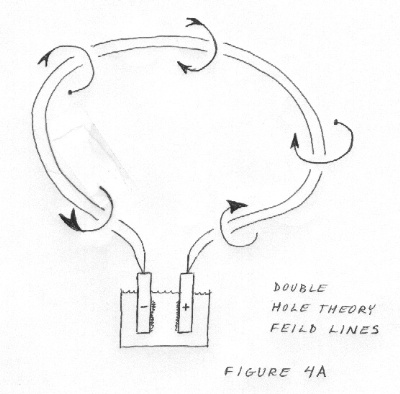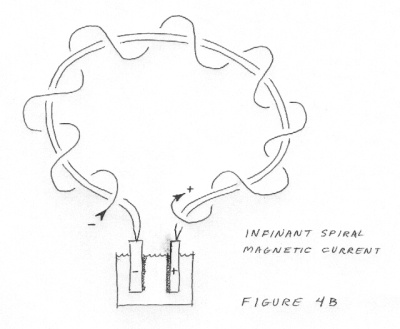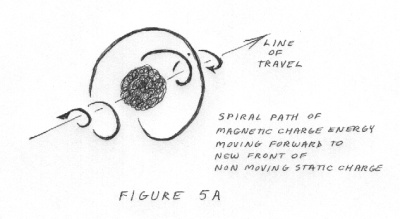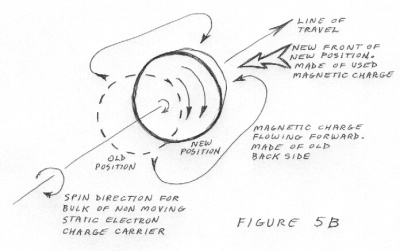|
|
|
It is difficult to view electricity and magnetism as being the same thing. Obviously they are closely related but is it the same EMF that moves electrons ? Yes. To see how it comes into existence from electrical origins another thought experiment is needed. Get the ideal battery used in the last experiment and connect a large loop of perfect wire ( pipe ) across its terminals. See figure 4. The wire is perfect because it has no resistance. The wire used in the hole theory explanation was allowed to have an extra space filled by the negative terminal and to have an empty space created by the positive terminal. That extra space and empty space will now be taken away. In their place is a magnetic field that rises around the wire. The field is uniform density from the negative terminal to the positive one. Its shape is that of rings around the wire.


Now we'll add a few new features to the hole theory to show where magnetic fields come from and go to. If magnetic arrows of spiral magnetic charge are drawn the double Hole Theory way they would have no arrow head at the negative terminal and no arrow tail at the positive terminal. In the middle of the arrow it would have both and they would be ½ size. The spiral path idea is easy to imagine as a the path for flowing magnetic charge. It helps to account for the variable energy storage ability of magnetic fields. It fits the description of Magnet Current.


Unfortunately, that nice mental picture has to be changed a few more times to see the real magnetic field. Remove the infinant spiral path and replace it with a single spinning cylinder. Remove the idea of having endpoints for flow around energy and replace it with the idea of having many wafers of magnetic field inside the wire. Those wafers get displaced outside of the wire where they become compressed against each other and seek to contract also. That compressed stack of magnetic wafers is the path that flowing EMF takes around the stationary path of spinning electron material. That is electron current 'flow' in a wire.
Recall that the wire will maintain its neutral charge from one end to the other and at all points in between. The EMF trying to enter the ends of the loop tries to upset that balance at both ends. Electron flow is called for by the battery. When the electrons begin to flow they upset the charge on the wire at each end of the wire. The wire responds by casting excess charge outside of itself to clear a path for the new moving electrons and their charges. That means the excess negative charge at the negative terminal and the excess positive charge at the positive terminal are both expelled from the wire. The charge cannot leave the wire even though it is cast out by the wire. The charge belongs to the atoms of the wire. It got displaced by the surplus ( or vacuum ) charge of the EMF induced electron flow inside the wire.
The previous paragraph mentioned positive charge. Examine what this is. Positive charge is a mirror image of negative charge. It does not actually exist though. It is a product of the Hole Theory. To remove the confusion from this double explanation look at what charge is. Charge is something that gives three conditions to space. Those conditions are 1) charged up positive 2) no charge & 3) charged up negative . Much like a great water level charge sloshes around the universe for various reasons. In places where there is a lot of charge the charge tries to flow to where there is less charge. That is equilibrium. The charged up condition is called negative. The no charge condition is called positive. By electron or by proton the charge tries to seek equilibrium. To a negative charge the no charge condition looks positive. The positive charge looks even more so. To a positive charge the no charge condition looks negative. The negative charge looks even more so. Remember this point for later on when the RF charge at the base of an antenna is looking at the no charge condition of the tip of the antenna. It is a half capacitor effect.
When the electron moves it creates a magnetic corridor for itself. See figure 5. The energy or inertia causing the motion compresses or pushes on the electron. The charge getting pushed on is not a solid but it still cannot pass through itself. Therefore it flows like a stream of water from the point of being pushed upon to the new front of the electron, where it becomes the new front of the new position. The place where it left is now where the back of the electron used to be. The path of this magnetic current is a spiral shape along the line of electron travel. It is a clockwise spiral for electrons as stated by 'The Right Hand Rule'. For protons it would become a counter clockwise spiral. Imagine that the spirals around an electron in motion are of infinant length. The displaced static electrical charge on the back side becomes fluid magnetic charge in motion. That magnetic charge 'current' flows spirally around the electron an infinant number of times to get to its new position on the front of the electron just in time to becomes the static electrical charge on the new front edge as the electron travels.
The spiral path of the magnetic current may be considered as a flywheel of energy. It takes energy to create it. It returns that exact amount of energy when it collapses. It is the corridor of the electron in motion. Imagine that the infinant spiral path is now a cylinder shape. It is spinning like a tubular flywheel. That is the true magnetic field. It doesn't have a beginning and ending point as the spiral does. It will deflect or displace other magnetic fields. It exists in compression to hold energy. It is a compression of charge energy from one end to the other. It will not leave the electron that it is a part of without a cause.
The magnetic field 'flywheel' can join with other 'flywheels' and spin collectively. That's what happens when many wires are wound into a coil. It's the reason that making a coil longer does not make it stronger. It just makes it bigger. The same is true for wider coils. The shorter the magnetic path the stronger the field strength. It is ironic the magnetic charge seeks to cause shorter paths where it becomes stronger and yet it is a byproduct of electric charge that seeks to spread itself evenly to its weakest condition every where.